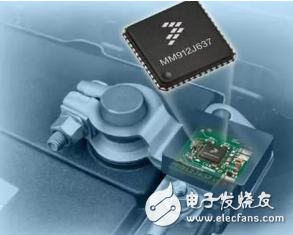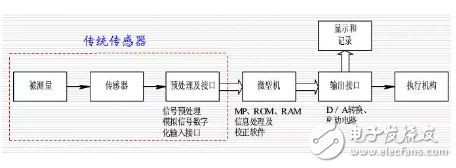Recently, the Ministry of Industry and Information Technology officially issued the "Three-Year Action Guide for Smart Sensor Industry (2017-2019)" (referred to as "Guide"). In order to implement the strategy of China Manufacturing 2025, the Ministry of Industry and Information Technology started the preparation of the guide in April 2016 and officially issued it on November 20, 2017. The "Guide" puts forward the overall goal. It is planned to achieve a clear breakthrough in the sensor industry by 2019. The scale of the smart sensor industry will reach 26 billion yuan, of which 5 enterprises will have more than 1 billion yuan in main business, and 20 enterprises will achieve 20 billion yuan. . The production capacity of microelectromechanical systems (MEMS) process lines has grown steadily.
What is a smart sensor?As a tool for humans to obtain information, sensors are an important part of modern information technology. In the traditional sense, the sensor output is mostly an analog signal. It does not have signal processing and networking functions. It needs to be connected to a specific measurement instrument to complete the signal processing and transmission functions. The intelligent sensor can realize the processing of the original data internally, and can exchange data with the outside world through a standard interface, and change the work of the sensor through software control according to actual needs, thereby realizing intelligent and networked. Due to the use of standard bus interfaces, smart sensors have good openness and scalability, which brings great development space for system expansion.

The concept of smart sensors was first proposed by NASA in the development of spacecraft and was formed in 1979. The spacecraft requires a large number of sensors to continuously send data such as temperature, position, speed and attitude to the processor on the ground or the spacecraft. Even with a large computer, it is difficult to process such huge data at the same time. Moreover, the spacecraft limits the size and weight of the computer, so it is desirable to have the information processing function of the sensor itself, so that the smart sensor is combined with the sensor and the microprocessor.
The smart sensor is a kind of new type of sensor that can sense and detect certain information of the measured object; can learn, reason and judge the processing signal; and has communication and management functions. Intelligent sensors have the ability to automatically zero, calibrate, compensate, and collect data. Its ability determines that the intelligent sensor also has high precision and resolution, high stability and reliability, better adaptability, and has a very high cost performance compared to the traditional sensor.
The early smart sensor processed and converted the output signal of the sensor and sent it to the microprocessor for processing. In the 1980s, smart sensors mainly used microprocessor as the core, and integrated sensor signal conditioning circuit, microelectronic computer memory and interface circuit on one chip, so that the sensor has certain artificial intelligence. In the 1990s, the intelligent measurement technology has been further improved, enabling the sensor to be miniaturized, structurally integrated, array-based, digital, easy to use, simple to operate, and has self-diagnosis function, memory and information processing functions, data storage. Features, multi-parameter measurement, networked communication, logical thinking, and judgment.

Smart sensors can be roughly divided into three types: sensors with judgment capabilities; sensors with learning capabilities; and sensors with creative capabilities.
Structural composition of smart sensors
The intelligent sensor system is mainly composed of sensors, microprocessors and related circuits, as shown in the figure. The sensor converts the measured physical quantity and chemical quantity into corresponding electric signals, and sends them to the signal modulation circuit, which is sent to the microprocessor after filtering, amplification, A/D conversion. After the microprocessor calculates, stores, and analyzes the received signal, the sensor and the signal conditioning circuit are adjusted through the feedback loop to adjust and control the measurement process; on the other hand, the processing result is transmitted to The output interface is processed by the interface circuit and outputted digital measurement results according to the output format and interface. The microprocessor is the core of the smart sensor. Because the microprocessor fully utilizes the functions of various softwares, the sensor is intelligent and greatly improves the performance of the sensor.

Fresnel lenses, also known as threaded lenses, are mostly thin sheets made of polyolefin material, or glass. One side of the lens is smooth, and the other side is engraved with concentric circles from small to large. Its texture It is designed according to the interference of light and the requirements of relative sensitivity and receiving angle.
The use of ordinary convex lenses will darken and blur the corners and corners. This is because the refraction of light only occurs at the interface of the medium. The convex lens sheet is thicker, and the part where the light travels straight in the glass will attenuate the light. If it is possible to remove the linear propagation part and only keep the refracted curved surface, a large amount of material can be saved while achieving the same light-gathering effect. The Fresnel lens uses this principle. The Fresnel lens looks like a piece of glass with countless concentric circles (ie Fresnel zone), but it can achieve the effect of a convex lens. If the projected light source is parallel light, the brightness of the image can be kept consistent after converging and projecting. .
Fresnel lens is equivalent to infrared and visible light convex lens in many cases, the effect is better, but the cost is much lower than ordinary convex lens. It is mostly used in occasions where accuracy is not very high, such as slide projectors, film magnifiers, infrared detectors, etc.
The Fresnel lens has two functions: one is focusing, that is, the pyro-infrared signal is refracted (reflected) on the PIR, and the second is to divide the detection area into several bright and dark areas, so that it can enter the detection area A moving object can produce a changing pyro-infrared signal on the PIR in the form of a temperature change.
Glass Fresnel Lens,Pmma Fresnel Lens,Compound Eye Fresnel Lens,Fresnel Lens
Bohr Optics Co.,Ltd , https://www.bohr-optics.com